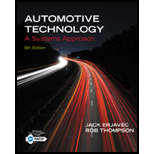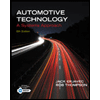
Automotive Technology: A Systems Approach (MindTap Course List)
6th Edition
ISBN: 9781133612315
Author: Jack Erjavec, Rob Thompson
Publisher: Cengage Learning
expand_more
expand_more
format_list_bulleted
Textbook Question
Chapter 17, Problem 8RQ
What causes gassing in a battery?
Expert Solution & Answer
Want to see the full answer?
Check out a sample textbook solution
Students have asked these similar questions
True or False? A fully charged new battery willhave a low conductance reading.
Which of the following statements about batterytypes is not true?a. Deep cycle batteries are designed to gothrough many charge and discharge cycles.b. A low-maintenance battery is a heavy-dutyversion of a normal lead-acid battery.c. Maintenance-free batteries require externalholes or vent caps.d. In a gel cell battery, gassing is minimized andvents are not needed.
Technician A fast charges a sulfated battery then reinstalls it in the vehicle. Technician B trickle charges a sulfated battery over 24 hours before reinstalling it. Who is correct?
a.
A only
b.
B only
c.
both A and B
d.
neither A nor B
Chapter 17 Solutions
Automotive Technology: A Systems Approach (MindTap Course List)
Ch. 17 - Define an electrolyte and its role in battery...Ch. 17 - Prob. 2RQCh. 17 - How is a battery leakage test conducted?Ch. 17 - Describe parasitic draw.Ch. 17 - How can you identify the high-voltage system in...Ch. 17 - How many volts are present in a fully charged...Ch. 17 - What is meant by the term specific gravity?Ch. 17 - What causes gassing in a battery?Ch. 17 - List five things that shorten the life of a...Ch. 17 - True or False? All electrochemical batteries have...
Ch. 17 - Prob. 11RQCh. 17 - True or False? A batteny is an electromechanical...Ch. 17 - True or False? The BCI determines battery ratings...Ch. 17 - Which of the following statements about battery...Ch. 17 - Which of the following statements about battery...Ch. 17 - Prob. 1ASRQCh. 17 - Technician A says that the reserve rating of a...Ch. 17 - Technician A says that battery straps should be...Ch. 17 - Technician A says jump-starting a battery can...Ch. 17 - Prob. 5ASRQCh. 17 - Technician A says that before a battery is...Ch. 17 - Technician A says that side post terminals need to...Ch. 17 - A vehicles battery goes dead after sitting for two...Ch. 17 - Technician A always wears safety glasses or...Ch. 17 - While discussing the results of a load test:...
Knowledge Booster
Learn more about
Need a deep-dive on the concept behind this application? Look no further. Learn more about this topic, mechanical-engineering and related others by exploring similar questions and additional content below.Similar questions
- Which of the following statements about battery types is not true? Deep cycle batteries are designed to go through many charge and discharge cycles. A low-maintenance battery is a heavy-duty version of a normal lead-acid battery. Maintenance-free batteries require external holes or vent caps. In a gel cell battery, gassing is minimized and vents are not needed.arrow_forwardHow many volts are present in a fully charged 12-volt battery?arrow_forwardTrue or False? All electrochemical batteries have three major parts: two electrodes or plates, and an electrolyte.arrow_forward
- Technician A says jump-starting a battery can damage electronic components. Technician B says a dead battery should be jump-started instead of recharged. Who is correct? Technician A Technician B Both A and B Neither A nor Barrow_forwardTrue or False? All electrochemical batteries havethree major parts: two electrodes or plates, andan electrolyte.arrow_forwardList five things that shorten the life of a battery.arrow_forward
- What basic factors affect the required time to recharge the battery pack in a BEV?arrow_forwardTechnician A says that battery straps should be used whenever a battery is lifted Technician B says that when a battery is removed, the positive cable should be disconnected first. Who is correct? Technician A Technician B Both A and B Neither A nor Barrow_forwardTechnician A says battery warranties are often prorated. Technician B says most prorated warranties have a deductible. Who is correct? Technician A Technician B Both A and B Neither A nor Barrow_forward
arrow_back_ios
SEE MORE QUESTIONS
arrow_forward_ios
Recommended textbooks for you
 Automotive Technology: A Systems Approach (MindTa...Mechanical EngineeringISBN:9781133612315Author:Jack Erjavec, Rob ThompsonPublisher:Cengage Learning
Automotive Technology: A Systems Approach (MindTa...Mechanical EngineeringISBN:9781133612315Author:Jack Erjavec, Rob ThompsonPublisher:Cengage Learning

Automotive Technology: A Systems Approach (MindTa...
Mechanical Engineering
ISBN:9781133612315
Author:Jack Erjavec, Rob Thompson
Publisher:Cengage Learning
Extent of Reaction; Author: LearnChemE;https://www.youtube.com/watch?v=__stMf3OLP4;License: Standard Youtube License